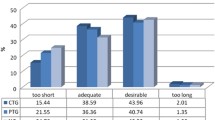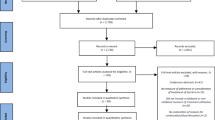Abstract
Consideration of the needs and objectives of individual patients significantly influences the behavior of erectile dysfunction (ED) patients and their partners. Evaluation of an erectile dysfunction (ED) patient requires individualized consideration of the expectations, needs, and objectives of the affected couple. These factors can influence attitudes toward diagnosis, treatment seeking, and ultimately treatment compliance and dropout. Relevant ED market research studies were presented at the 2006 annual meeting of the American Urological Association. The studies explored the prevalence of ED, access to treatment, and ED patient attitudes and preferences. Several barriers continue to influence treatment-seeking behavior in men with ED. These barriers have had a negative impact on the ED patient and marketplace resulting in low rates of utilization and high rates of dropout from therapies for ED.
Similar content being viewed by others
References
Zakaria L, Anastasiadis A, Shabsigh R (2001) Common conditions of the aging male: erectile dysfunction, benign prostatic hyperplasia, cardiovascular disease and depression. Int Urol Nephrol 33:283
Johannes CB, Araujo AB, Feldman HA, et al (2000) Incidence of erectile dysfunction in men 40–69 years old: longitudinal results from the Massachusetts male aging study. J Urol 163:460
Araujo AB, Durante R, Feldman HA, et al (1998) The relationship between depressive symptoms and male erectile dysfunction: cross-sectional results from the Massachusetts male aging study. Psychosom Med 60:458
Shabsigh R, Klein LT, Seidman S, et al (1998) Increased incidence of depressive symptoms in men with erectile dysfunction. Urology 52:848
Seidman SN, Roose SP, Menza MA, et al (2001) Treatment of ED in men with depressive symptoms: placebo-controlled trial with sildenafil. Am J Psychiatry 158:1623
Laumann EO, Paik A, Rosen RC (1999) Sexual dysfunction in the United States: prevalence and predictors. JAMA 281:537
Giuliano F, Chevret-Measson M, Tsatsaris A, Reitz C, Murino M, Thonneau P (2002) Prevalence of erectile dysfunction in France: results of an epidemiological survey of a representative sample of 1004 men. Eur Urol 42(4):382–389
Guest JF, Das Gupta R (2002) Health-related quality of life in a UK-based population of men with erectile dysfunction. Pharmacoeconomics 20:109
Hakim J, Subit M, Kandzari S, et al (2002) Quality control in the screening of erectile dysfunction-results of a survey. Urology 60:125
Burchardt M, Burchardt T, Anastasiadis AG, et al (2001) Erectile dysfunction is a marker for cardiovascular complications and psychological functioning in men with hypertension. Int J Impot Res 13:276
De Berardis G, Franciosi M, Belfiglio M, et al (2002) Quality of care and outcomes in type 2 diabetes (QuED) study group. Diabetes Care 25:284
Fagelman E, Fagelman A, Shabsigh R (2001) Efficacy, safety, and use of sildenafil in urologic practice. Urology 57:1141
Shabsigh R, Padma-Nathan H, Gittleman M, et al (2000) Intracavernous alprostadil alfadex is more efficacious, better tolerated, and preferred over intraurethral alprostadil plus optional actis: a comparative, randomized, crossover, multicenter study. Urology 55:109
Mulhall JP, Jahoda AE, Ahmed A, et al (2001) Analysis of the consistency of intraurethral prostaglandin E(1) (MUSE) during at-home use. Urology 58:262
Wagner G, Fugl-Meyer KS, Fugl-Meyer AR (2000) Impact of erectile dysfunction on quality of life: patient and partner perspectives. Int J Impot Res 12(suppl4):S144
MacDonagh R, Ewings P, Porter T (2002) The effect of erectile dysfunction on quality of life: psychometric testing of a new quality of life measure for patients with erectile dysfunction. J Urol 167:212
Derogatis LR, Rosen R, Leiblum S, et al (2002) The female sexual distress scale (FSDS): initial validation of a standardized scale for assessment of sexually related personal distress in women. J Sex Marital Ther 28:317
Althof SE (2002) When an erection alone is not enough: biopsychosocial obstacles to lovemaking. Int J Impot Res 14(suppl1):S99
Armstrong DK, Convery AG, Dinsmore WW (1994) Reasons for patient drop-out from an intracavernous auto-injection programme for erectile dysfunction. Br J Urol 74:99
Fichten CS, Spector I, Libman E (1988) Client attributions for sexual dysfunction. J Sex Marital Ther 14:208
Ehrensaft MK, Condra M, Morales A, et al (1994) Communication patterns in patients with erectile dysfunction and their partners. Int J Impot Res 6:25
Shirai M, Takimoto Y, Ishii N, et al (2001) Influence of erectile dysfunction on daily life and general attitudes towards treatments. Nippon Hinyokika Gakkai Zasshi 92(7):666
Sundaram CP, Thomas W, Pryor LE, et al (1997) Long-term follow-up of patients receiving injection therapy for erectile dysfunction. Urology 49:932
Lottman PE, Hendriks JC, Vruggink PA, et al (1998) The impact of marital satisfaction and psychological counselling on the outcome of ICI-treatment in men with ED. Int J Impot Res 10:83
Shabsigh R, Perelman M, Laumann EO, Lockhardt D (2004) Drivers and barriers to seeking treatment for erectile dysfunction, a comparison of 6 countries. B JU Int 94(7):1055–1065
Author information
Authors and Affiliations
Corresponding author
Rights and permissions
About this article
Cite this article
Shabsigh, R., Stone, B. Understanding the needs and objectives of erectile dysfunction patients. World J Urol 24, 618–622 (2006). https://doi.org/10.1007/s00345-006-0128-5
Published:
Issue Date:
DOI: https://doi.org/10.1007/s00345-006-0128-5




